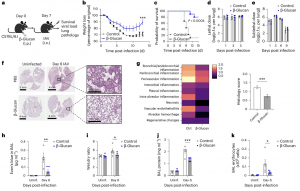Beta-glucan is a natural polysaccharide found in the cell walls of fungi, yeast, and grains like oats and barley. While traditionally recognized for its immune-boosting properties, this study demonstrates that beta-glucan can reprogram immune cells to prevent excessive inflammation, a common cause of flu-related fatalities.
A new study has revealed that beta-glucan, a component found in all fungi, can protect against influenza-related lung damage, enhancing immune resilience and improving survival rates (Figure 1). The research highlights beta-glucan’s potential as a therapy for influenza and other respiratory viral infections by promoting disease tolerance rather than solely targeting viral replication.

Figure 1: β-Glucan treatment induces disease tolerance against IAV. a, Mice were infected with IAV at day 7 post-β-glucan treatment i.p. b,c, Weight loss (b) and survival (c) monitored over time (n = 10) of mice infected with a lethal dose of IAV (120 p.f.u.). d, Viral burden quantified at several time points post-IAV infection with a lethal dose (n = 5). e, Viral burden quantified at several time points post-IAV infection with a sublethal dose (50 p.f.u.; n = 5). f, Representative micrographs of lung histology from β-glucan (7 d)-treated mice stained with H&E day 6 post-IAV infection.Scale bar, 200 μm. g, Lung histology scoring at day 6 post-IAV infection after β-glucan treatment (n = 5). h–k, Mice were infected with a sublethal dose of IAV at day 7 post-β-glucan, followed at day 6 post-IAV infection: quantification of endothelial permeability (h), pulmonary edema (i), BAL protein (j) and BAL erythrocytes (k) (n = 5). Data are represented as mean ± s.e.m. Data were analyzed using two-tailed, unpaired Student’s t-test (g) or two-way ANOVA followed by Šidák’s multiple-comparison tests (b and h–k). Survival was monitored by a log(rank) test (c). *P < 0.05, ***P < 0.001, ****P < 0.0001. i.n., intranasally; uninf., uninfected. Illustrations in a created using BioRender.com.
The study explored how pre-treatment with beta-glucan improved outcomes in mice exposed to influenza. The results showed:
- Reduced lung damage and improved lung function
- Lower risk of severe illness and death
- Modulated immune responses without impairing viral clearance
While most flu treatments aim to inhibit viral replication, this study focused on enhancing disease tolerance—the body’s ability to withstand infection without severe tissue damage.
Key findings include:
- Beta-glucan reduced excessive neutrophil activity, a primary driver of lung inflammation during severe influenza.
- Enhanced survival rates in flu-infected mice without compromising viral control.
- Pre-treatment with beta-glucan primed immune cells for a balanced response, preventing the immune overreaction that often leads to respiratory failure.
The findings suggest that beta-glucan-based therapies could complement traditional antivirals, especially for high-risk populations during flu season.
With flu season underway and the threat of bird flu (H5N1) looming, the researchers emphasize the urgent need for effective therapeutic strategies. By modulating immunity rather than solely targeting pathogens, beta-glucan could redefine influenza treatment, offering new hope for reducing flu-related complications and deaths.
Journal article: Nargis Khan et al, 2025. β-Glucan reprograms neutrophils to promote disease tolerance against influenza A virus, Nature Immunology.
Summary by Stefan Botha










